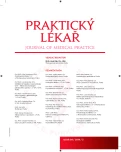Results of Adam’s test of scoliotic vertebral rotation in primary school students
Authors:
G. Hrušková; E. Ehler
Authors‘ workplace:
Katedra biologie a environmentálních studií
; Vedoucí katedry: doc. RNDr. Lubomír Hrouda, CSc.
; Univerzita Karlova v Praze, Pedagogická fakulta
Published in:
Prakt. Lék. 2014; 94(3): 137-140
Category:
Of different specialties
Overview
The aim of our study
was to analyze the results of Adam’s forward bend test of asymetry of paravertebral muscles in primary school children. Our intention was to identify the main parameters of growth and development which can predict the Adam’s angle. To reach this goal, we have sampled 270 boys and 270 girls ageing six to fourteen years. These probands were the pupils of primary schools in the Litoměřice region of the Central Bohemia, Czech Republic. The gathered data include Adam’s angle, body height, body weight, computed BMI, age and sex. In our sample set, we have found the positive Adam’s angle, higher than five degrees, in 27 samples (5,0 %). This number is slightly higher than previously reported data from the Czech children population. By linear regression analysis we have pinpointed the increasing age and body height as the main predictors for positive Adam’s angle in our data set. Positive Adam’s angle was also found more frequently in girls then in boys, the ratio was 2,4 : 1. Body height, body weight and BMI from our data set were compared to these of the 6. National Anthropological Survey of Children and Youth from 2001. We didn’t find the two data sets statistically different. Therefore our data can confirm the fading of secular trend in Czech children. Adam’s forward bend test is a fast and straightforward screening method, which can detect scoliotic deformity of the spine.
Keywords:
Adam’s forward bend test – scoliosis – primary school students – body height, body weight
Sources
1. Blaha J. Idiopatická skolióza – screening, prognostika a konzervativní terapie. Hradec Králové: Gaudeamus 2005.
2. Čermák J., Chválová O., Botlíková V. Záda už mě nebolí. Praha: Svojtka a Vašut 1992.
3. Dungl P. a kol. Ortopedie. Praha: Grada Publishing 2005.
4. Fetter V., Prokopec M., Suchý J., Titlbachová S. Antropologie. Praha: Nakladatelství Academia 1967.
5. Chong K., Letts R., Cumming G. Influence of spinal curvature on exercise capacity. J. Ped. Orthop 1981; 1(3): 251–254.
6. Janíček P. Ortopedie. Brno: MU 2001.
7. Kobzová J, Vignerová J, Bláha P, Krejčovský L, Riedlová J. Základní tělesné rozměry dětí a mládeže České republiky podle výsledků 6. celostátního antropologického výzkumu dětí a mládeže 2001. Česká antropologie 2003; 53: 30–34.
8. Kokavec M, Novorolský K. Skolióza a pohybová aktivita u detí. Pediatria pre prax 2007; 2: 70–74.
9. Krásničanová H, Lebl J. Růst dětí a jeho poruchy. Praha: Galén 1996.
10. Lomíček M. Idiopatická skolióza. Praha: Avicenum 1973.
11. Lonstein JE, Carlson JM. The prediction of curve progression in untreated idiopathic scoliosis during growth. J Bone Joint Surg 1984; 66: 1061–1071.
12. Mau H. Die Äthiopathogenese der Skoliose. Stuttgart: Enke 1982.
13. Newton PO, Wenger DR. Idiopathic scoliosis. In Morrissy RT, Weinstein SL. Lovell and Winter’s Pediatric Orthopaedics. 6th ed. Philadelphia: Lippincott, Williams & Wilkins 2006; 693–762.
14. Novotná H., Kohlíková E. Děti s diagnózou skolióza. Praha: Olympia 2000.
15. Nussinovitch M, Finkelstein Y, Amir J, Greenbaum E, Volovitz B. Adolescent screening for orthopedic problems in high school. Public Health 2002; 116: 30–32.
16. Riegerová J, Přidalová M, Ulbrichová M. Aplikace fyzické antropologie v tělesné výchově a sportu. 3. vyd. Olomouc: Hanex 2006.
17. Sosna A, Vavrečka J. Základy ortopedie. Praha: Triton 2001.
18. Susanne C, Bodzsár ÉB. Patterns of secular change of growth and development. In Bodzsár, É. Secular growth changes in Europe. Budapest: Eötwös University Press 1998; 5–26.
19. Vercauteren M. Trunk asymmetries in a Belgian school population. Spine 1982; 7: 555–562.
20. Vignerová J, Riedlová J, Bláha P, a kol. 6. celostátní antropologický výzkum dětí a mládeže 2001, Česká republika. 1. vyd. Praha: PřF UK a SZÚ 2006.
21. Vlach O. Léčení deformit páteře. Praha: Avicenum 1986.
Labels
General practitioner for children and adolescents General practitioner for adultsArticle was published in
General Practitioner

2014 Issue 3
- Memantine in Dementia Therapy – Current Findings and Possible Future Applications
- What Effect Can Be Expected from Limosilactobacillus reuteri in Mucositis and Peri-Implantitis?
- Memantine Eases Daily Life for Patients and Caregivers
- Metamizole vs. Tramadol in Postoperative Analgesia
- Metamizole at a Glance and in Practice – Effective Non-Opioid Analgesic for All Ages
Most read in this issue
- Allergy vaccine in general practice
- Children poisoning – experiences of Poisons Information Centre in Prague
- Facial pain: rhinosinusitis or other reason?
- Results of Adam’s test of scoliotic vertebral rotation in primary school students
